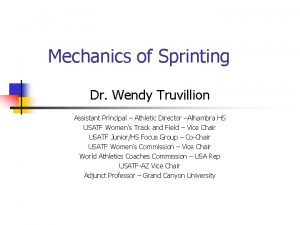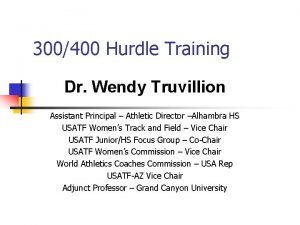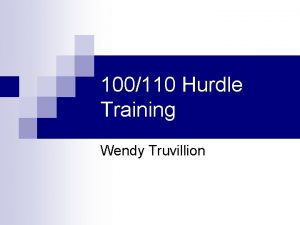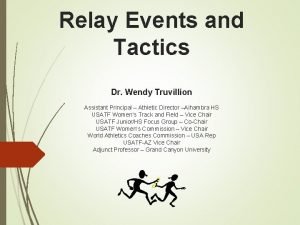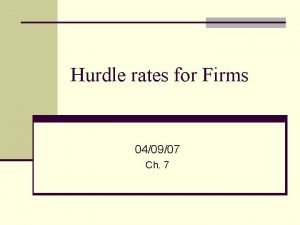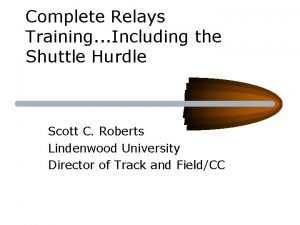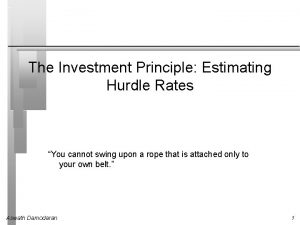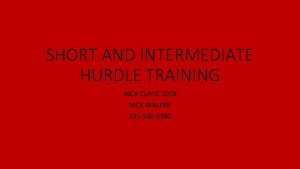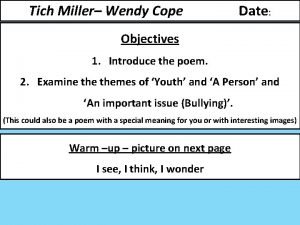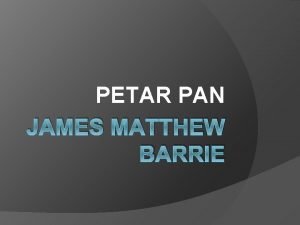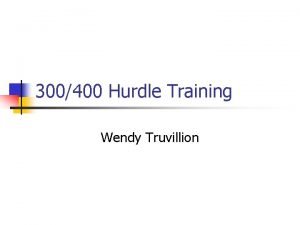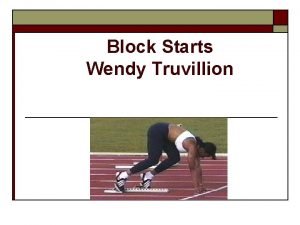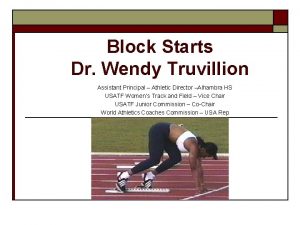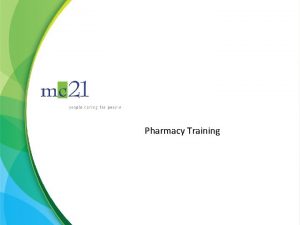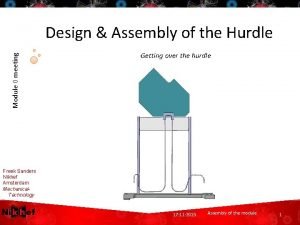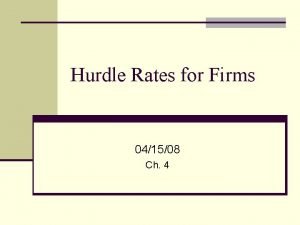100110 Hurdle Training Wendy Truvillion Introduction n n




















- Slides: 20

100/110 Hurdle Training Wendy Truvillion

Introduction n n Hurdling is sprinting with rhythm! Hurdling deviates as least as possible from normal sprinting. The abilities needed in hurdling are very similar to those needed in the sprint events, and should be developed the same way. Our focus, first, last, and always must be establishing and maintaining SPEED between and over the hurdles!

Specifics to the 100/110 hurdles 8 steps to the 1 st hurdle (developmental hurdlers may need to take 9 steps until they become stronger and faster) n 3 steps between each hurdle n 5 - 6 steps off of the 10 th hurdle to the finish line n n Flexibility and mobility are vital to the event, and the athletes success. n Modify sprint mechanics to negotiate the barrier.

Measurements in Hurdling RACE Women 100 H Men 110 H Distance Run-In Hurdle to 1 st Hur Between Distance Height Hurdles off last hur 13 m 8. 5 m 10. 5 m 33” 15 yds 10 yds (13. 72 m) (9. 14 m) 46 ft 42” (14. 02 m)

Technical Demands in the Start n n Advanced hurdlers need to modify the sprint acceleration process (out of the blocks) in order to better negotiate the hurdle. Stride length is sacrificed in order to fit eight steps into the acceleration to the 1 st hurdle. Range of motion at the hips is decreased. Stride frequency is higher in the approach to the 1 st hurdle. n n n Low heel recovery in drive phase. The progression of the body angles must occur quickly to better prepare for the 1 st hurdle in 8 steps. Hips are tall by stride 6 in order to prepare for attack of 1 st hurdle.

Mechanical Demands n n n Increasing stride frequency and developing faster rhythms are important goals. The drive phase should extend until the 3 rd hurdle. The run between the hurdles is a modification of the maximal velocity mechanics (shuffle). n n Stride length is decreased between the hurdles in order to fit the needed three steps. Novice and developmental hurdlers may take more than three steps between the hurdles. If 4 or 5 steps are needed (for beginners) allow it, but train with the hurdles “discounted” in order to develop the 3 step rhythm. Also, practice using alternate legs. Heel recovery is lower than in normal sprinting, due to the decrease in range of movement.

Mechanical Demands n n Push off angles at touchdown are primarily vertical, as in maximal velocity. Range of motion in the hips between the hurdles is usually decreased, due to the “shuffle” steps.

Hurdling Techiques n Block Start: ¨ Lead leg in the back block (quick side) ¨ Trail leg in the front block (power side) ¨ Normal sprint start: aggressive, powerful, quick arms, quick legs, focus. ¨ At “set” focus on pressure back into the pedals. n Start to the 1 st hurdle: ¨ ¨ ¨ Hips tall after 6 th stride Arrive at hurdle in a position ready to negotiate the barrier Consistent stride pattern (frequency) “Race” to the take-off mark (1. 7 – 2. 0 m). At “cut step” focus on pushing the “hips” through the hurdle. Lead with the knee, not the foot.

Hurdling Techniques n Take Off: ¨ Hurdling begins from the drive phase of the lead leg (step 7). ¨ Concentrate on driving hips over the hurdle rail ¨ Project C of M up over the hurdle with hips tall and forward. ¨ Take-off is about 1. 7 – 2. 0 m away from hurdle. n “Cut step” (w/trail-leg): ¨ ¨ ¨ Trail leg initiates the takeoff into the hurdle “cut step” is a shortened stride which enables the raising of the hips in preparation for hurdle clearance. Ankle passes below the knee Thigh blocks short of parallel, hips are tall (not squatty or mushy). Contact is active and almost under C of M, and toe is up.

Hurdle Techniques n Lead-Leg: ¨ ¨ ¨ Punch the knee toward the hurdle, don’t lead with foot. Flexed knee, not locked At top of hurdle, thigh decelerates causing the lower leg to swing forward (extend) As foot clears the rail, thigh accelerates down and back into the track. Landing should be “hips tall”, no mushing out Touchdown landing should be about 1 – 1. 5 m on the back side of the hurdle

Hurdle Techniques n Trail-leg: Toe up, heel up, knee pulled tightly to the body ¨ Punch knee through, rotate knee and foot outward, keep heel and knee level, so as to not bang inner-ankle on the rail. ¨ As entire leg clears the rail, punch knee forward (close the door), and accelerate foot down and back into the track. ¨ Landing should be “hips tall”, no mushing out ¨

Hurdle Techniques n “Get-away” Stride: ¨ Trail-leg landing on back side of the hurdle. ¨ Toe up, knee up, aggressive drive down and back into the track. ¨ Hips tall, no mushing out. ¨ Good, stern body posture ¨ Active arms to balance your forward

Arm Actions n Lead-leg Arm (right): ¨ ¨ ¨ Forearm flexes and extends forward Rotate arm internally Elbow angle same as leadleg, knee angle (30 – 45 degrees) Arm stops at shoulder level. As C of M passes over the hurdle rail, drive lead arm back and down. n Trail-leg Arm (left): Little deviation from sprinting form. ¨ With bent elbow, trail arm opens out to the side (elbow up) to allow trail-leg to pass underneath. ¨ As trail-leg passes, arm drives outward and backward to balance lowerlimbs ¨ A trail-leg touchdown, arm is thrust forward to continue sprint form. ¨

Critical Components of the Race n n Cut Step ¨ Most crucial stride ¨ Puts hips in most optimal position for smooth clearance ¨ Active plant high on ball of foot (no heel collapse) to facilitate rotation at take-off (hingemoment). Get-away Stride: ¨ “Close the door” ¨ Accelerate thigh down and back into the track ¨ Active plant on ball of foot, and under C of M ¨ Shortest stride because lead leg is in an inefficient position to apply force. n n Second Stride: ¨ Longest stride ¨ regular running stride ¨ Hips tall ¨ Sets up the ‘cut step’ Landing: ¨ Active plant on ball of foot. ¨ Accelerate thigh down and back into the track. ¨ On lead-leg landing, shoulders are slightly ahead of hips ¨ Ankle-cocked, no mushing out ¨ “Tear” at the track and “get to gettin”

Run-in from the last hurdle n n Most neglected part of the race. Should be practiced during training sessions Know the number of strides to the finish off the last hurdle. Practice accelerating and driving off the last hurdle. n Focus on proper body position coming off the last hurdle to ensure an active and optimal run-in.

Too high over the first hurdle n Fault ¨ ¨ ¨ Too close to the hurdle Power foot planted on heel Non-existent or non-active cut step (normal step) Lead was with the foot, not the knee Athlete afraid of hurdle (hesitant, threatened) n Correction Keep athlete in sprint posture longer ¨ Practice hips tall, make cut step active and on the toes ¨ Rehearse proper lead leg mechanics and body posture going into the hurdle ¨ Use breakaway hurdles in practice (reduces threat; confidence increase) ¨

Off balance coming off the hurdle n Fault ¨ Lead leg and opposite are driven inward and hot in the direction of travel ¨ Trail leg opening too soon ¨ Athlete may be too close to the hurdle n Correction ¨ Work on synchronizing lead leg mechanics; use sprint arm action, not across the body ¨ Work on synchronizing trail leg mechanics and keeping the leg folded until knee is pointing in the direction of travel.

Too far from the first hurdle n Fault Sprint strides during initial acceleration from blocks are too short ¨ Blocks may be set too close together resulting in too short of an initial stride ¨ Arm action in acceleration may be too passive ¨ n Correction Work on improving athletes contractive strength level to insure sufficient stride length to make the distance in 8 steps ¨ Move blocks to medium spacing and check body angles in start position ¨ Lengthen arm action and increase the amplitude of arm movement ¨

Hitting hurdles late in the race n Fault ¨ Loss of rhythm ¨ Too close to hurdles ¨ Loss of concentration ¨ Fail to maintain hips tall position causing athlete to sit and not maintain good sprint mechanics n Correction ¨ ¨ ¨ Trail leg opening too soon, thus causing getaway stride to be too long resulting in power foot being too close to the next hurdle Maintain tall hip position and good sprint mechanics Keep trail leg tight and shorten getaway stride Learn to control attention to what’s happening in your lane Concentrate on your own rhythm.

Thank you! n Questions and Answers References: n USATF Coaches Education Level I and II Curriculum Manual, 2006 n
 Wendy truvillion
Wendy truvillion Wendy truvillion
Wendy truvillion Wendy truvillion
Wendy truvillion Wendy truvillion
Wendy truvillion Hurdle rate
Hurdle rate Define hurdle technology
Define hurdle technology Hurdle rate
Hurdle rate Shuttle hurdle relay rules
Shuttle hurdle relay rules Organizational hurdles
Organizational hurdles Cognitive hurdle
Cognitive hurdle Hurdle principle
Hurdle principle Intermediate hurdle drills
Intermediate hurdle drills Hurdle model of price discrimination
Hurdle model of price discrimination Hurdle method of price discrimination
Hurdle method of price discrimination Wendy levinson
Wendy levinson Who wrote tich miller
Who wrote tich miller The veldt wendy character traits
The veldt wendy character traits How did tich miller die
How did tich miller die Kako izgleda petar pan
Kako izgleda petar pan Wendy kinnear
Wendy kinnear Wendy schell
Wendy schell
